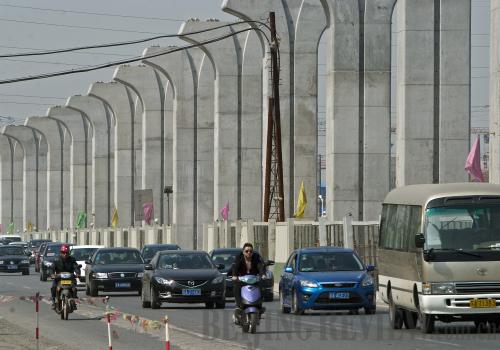|
 |
|
KICK OUT THE JAMS: Traffic flows alongside the Ningtian Light Railway project, scheduled to span 44.5 km upon completion in 2014, in Nanjing, east China's Jiangsu Province, on May 1, 2013 (CFP) |
On April 2, the Beijing Municipal Government announced that the city will continue to limit the number of cars in rush hours according to license plate numbers.
The restriction, which was first introduced in 2008 to restrict driving times based on the last numbers on license plates, is aimed at improving air quality and cutting traffic, authorities said. With the move, one-fifth of the capital's 5.27 million registered cars will not be allowed to drive in downtown areas between 7 a.m. and 8 p.m. on workdays over the next 12 months.
In recent years, with fast growth of the automobile industry in China, traffic jams have become a common phenomenon in many cities, even in second- and third-tier cities.
Management dilemma
According to the National Bureau of Statistics, China had more than 120 million automobiles at the end of 2012, including 93.09 million privately owned vehicles.
In order to tackle gridlock, several cities have started considering ways to reduce the number of cars on urban roads through traffic restrictions and auctions or lotteries of license plates.
Shanghai was the first city to limit supplies of new plates through auctions in 1994. Prices of license plates skyrocketed to 90,000 yuan ($14,562) in March.
In January 2011, Beijing ushered in a monthly lottery to control car purchases by capping new registrations at 240,000 each year, with 88 percent for small passenger cars.
In July of the same year, a similar lottery was introduced in Guiyang, southwest China's Guizhou Province, in an effort to tame traffic.
With a hybrid auction-lottery system, Guangzhou in south China's Guangdong Province became the fourth city in China to take restrictive measures on new cars in August last year.
According to the initiative, half of the annual 120,000 new registrations in Guangzhou will be given out through auction, while the other 60,000 plates will be allocated through a lottery.
Besides, some other big cities, which share similar situations including population, levels of economic development and scales of car market with Guangzhou, are reportedly most likely to unveil restrictive policies to counter traffic woes.
In February, Shenzhen in Guangdong started soliciting public feedback on plans to restrict car purchases.
Last August, Xi'an in northwest China's Shaanxi Province announced it might limit the number of vehicles in the city. Though the municipal government took back the controversial statement a week later, it raised a storm of conjecture nationwide that major cities including Tianjin, Hangzhou in Zhejiang Province and Zhengzhou in Henan Province are thinking about such measures.
Even in Shiyan, a small city in central China's Hubei Province, a local newspaper reported that traffic jams took place almost every day and the possibility of limitations could not be ruled out. "Shiyan has 195 vehicles per 1,000 people, higher than Guangzhou's 150," it said.
"Since many cities face the ever-increasing pressure from traffic congestion and vehicle emissions in the process of urbanization, they are expected to adopt such kinds of restrictions," said Zhong Shi, an auto industry observer in Guangzhou.
While proponents argue that restrictions are effective to address traffic problems for the time being, some insiders expressed different views.
Jiang Libiao, a professor at the School of Mechanical and Automotive Engineering of the Guangzhou-based South China University of Technology, said that the car ownership control policies can only help postpone serious traffic gridlock but cannot solve the problem unless road resources are taken full advantage of and the public transport system is improved.
Fu Yuwu, Secretary General of the Society of Automotive Engineers of China, warned that to ease traffic congestion through restricting car purchases will not work well and the abrupt transition of the government's policies on auto industry will hamper its healthy development.
China outpaced the United States as the world's largest auto market in 2009. It is estimated that the designed production capacity of China's 30 major automakers will reach 40 million vehicles by 2015.
Some 19.30 million motor vehicles were sold in China in 2012, a mild increase of 4.33 percent from 2011, according to the China Association of Automobile Manufacturers.
"Car purchase restrictions in Beijing have affected 3 percent of the growth in the number of cars nationwide, and Guangzhou's restrictions will affect 1 percent. The car market will be squeezed if more cities follow suit," said Jia Xinguang, an independent auto industry analyst in Beijing.
| 